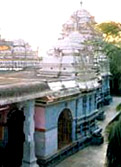 Location: Ryoli, Rajamundry, East Godavari
Location: Ryoli, Rajamundry, East Godavari
Deity: Lord Vishnu
The idol in the Sri Jaganmohini Kesava and Gopala Swamy Temple, is made of black stone depicting Maha Vishnu and Mohini in the front and rear sides, and is a marvel of sculptural dexterity.
Legend: According to Sthala Puranam, the gods and demons fought over the sharing of devine nectar. Vishnu came to the rescue of gods in the guise of Mohini and convinced both the rivalry groups promising to distribute the nectar equally between gods and demons. Lord Shiva became fascinated by the beauty of Mohini and allured her. He chased her in the presence of Parvati, which resulted in the birth of Ayyappa Swamy. One flower from the plait of Mohini fell down and was smelt by Lord Siva. The place where the flower fell was named Ryali meaning Fall. A rare feature at Ryali are the Vishnu and Siva Temples that face each other in the East and West direction.
Sri Raja Vikrama Deva dreamt that Vishnu directed the Raja to get the wooden made chariot pulled in the area and where the nail fell, the shrine was found under ground. Raja did accordingly and constructed a small temple during 11th Century and arranged for its worship during his regime.
The Shrine is Salagrama Ekasila and is 5 feet in height and 3 feet wide. Salgramasila is itself in the form of Sri Maha Vishnu. The idol of Sree Kesava Swamy varu of Sri Mahavishnu is in front and Jagan Mohini on back. The ten incarnations of Vishnu with consorts are beautifully, sculptured around the shrine. A rare feature is that, Ganga flows from the feet of Vishnu and is the origin of Akasa Ganga, which can be seen here.





















